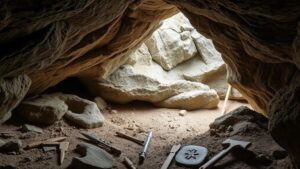Detecting for Gold Nuggets in Bedrock Cracks of Mountain Streams
Detecting for Gold Nuggets in Bedrock Cracks of Mountain Streams
Gold prospecting is a time-honored tradition that combines science, art, and a bit of luck. One of the most promising methods for locating gold nuggets is by exploring the bedrock cracks found in mountain streams. This article delves into the techniques and strategies used to detect gold in these unique geological formations.
The Geology of Gold Formation in Streams
Understanding the geological context is crucial for gold prospecting. Gold is primarily found in its native form within the crust of the Earth, often associated with quartz veins and other hard rock formations. As erosion takes place, these deposits are fragmented and can be transported by water over time.
In mountain streams, gold nuggets can become lodged in bedrock cracks due to their weight and density. Notably, gold has a specific gravity of around 19.3, making it much heavier than most streambed materials. As a result, as lighter sediments are washed away, gold particles can settle into cracks and crevices.
Essential Tools for Detection
This gold prospecting endeavor requires specific tools to effectively search for nuggets in bedrock cracks:
- Metal Detector: A high-quality metal detector designed for gold prospecting can detect the unique signature of gold in the bedrock. Look for models with a minimum frequency of 18 kHz.
- Pans and Sluices: Gold pans and small sluices are used to separate gold from sediment when testing stream gravels. But, these can also be useful when sluicing off deposits near bedrock.
- Pick and Chisel: These tools are useful for prying open cracks in the bedrock to access potentially hidden gold nuggets.
- Safety Gear: Equip yourself with gloves, a good pair of boots, and safety goggles to protect against sharp rocks and potential instability in the stream.
Effective Techniques for Detecting Gold Nuggets
There are several proven techniques to maximize gold nugget detection in bedrock cracks, including:
- Observation of Water Flow: Analyze how water flows over the bedrock. Areas where the current speeds up or slows down can create natural traps for heavy metals, including gold. Look for bends in the stream, pools, or behind boulders.
- Systematic Searching: Approach the search methodically. Use a metal detector, concentrating on cracks and holes in the rock. Sweep slowly and overlap your movements to ensure thorough coverage.
- Sampling Techniques: Collect samples from different cracks and test them for gold content. Use your metal detector after removing a small amount of material. This technique can help you identify productive areas.
Case Studies: Successful Nugget Finds
Several documented case studies illustrate the effectiveness of detecting gold nuggets in bedrock cracks. For example:
- The California Gold Rush, 1849: Prospectors during this era often discovered gold nuggets lodged within bedrock cracks, leading to the establishment of mining camps throughout the Sierra Nevada mountains.
- Modern Techniques in Alaska: Recent findings by hobbyist prospectors in Alaskan streams have revealed gold nuggets weighing several ounces from bedrock cracks, using advanced metal detectors explicitly designed for nugget hunting.
Environmental Considerations and Regulations
When prospecting for gold nuggets in mountain streams, it is essential to consider environmental impact and local regulations:
- Environmental Impact: Erosion and disturbance of habitats can have significant consequences. Always strive for minimal disruption.
- Legal Regulations: Be sure to check local laws regarding prospecting rights. In many cases, permits are required for searching and extracting materials from public lands.
Conclusion: Actionable Takeaways
Detecting gold nuggets in bedrock cracks of mountain streams can be a rewarding experience, combining both adventure and the potential for significant finds. To maximize success, consider the geological factors at play, utilize the right tools, employ effective detection techniques, and remain mindful of environmental and regulatory obligations. Whether you are a seasoned prospector or a novice, understanding these principles will enhance your chances of uncovering hidden treasures.



